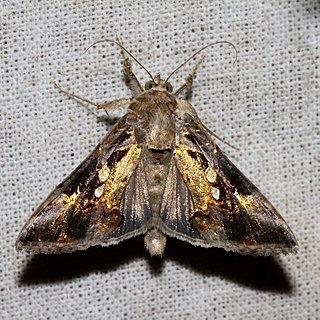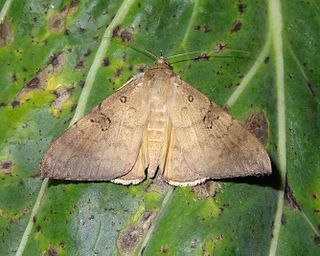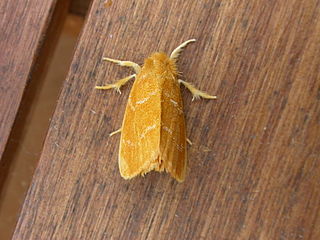
The common Quaker is a moth of the family Noctuidae first described by Johan Christian Fabricius in 1775. Some authors prefer the synonym Orthosia stabilis(Denis & Schiffermüller, 1775). It is distributed throughout Europe and is also found in Turkey, Israel, Transcaucasia, Russia and eastern Siberia.

Theretra oldenlandiae, the impatiens hawkmoth, taro hornworm or white-banded hunter hawkmoth, is a member of the family Sphingidae.

Mocis frugalis, the sugarcane looper, is a moth of the family Erebidae. The species was first described by Johan Christian Fabricius in 1775. It is found in several parts of the world, including India, Sri Lanka, West African countries and other Oriental regions. The adult is a fruit piercer and a major pest of crops.

Grammodes geometrica is a moth found from the Mediterranean east to Oriental and Australasian tropics of India, Sri Lanka, Java and Australia. The adult is a fruit piercer. The species was first described by Johan Christian Fabricius in 1775.

Amata is a genus of tiger moths in the family Erebidae. The genus was erected by Johan Christian Fabricius in 1807.

Hippotion boerhaviae, the pale striated hawkmoth, is a moth of the family Sphingidae.
Amata humeralis is a species of moth of the family Erebidae first described by Arthur Gardiner Butler in 1876. It is found in Australia, where it has been recorded from Western Australia, the Northern Territory, Queensland and New South Wales.
Amata xanthosoma, the yellow tiger moth, is a species of moth of the family Erebidae first described by Alfred Jefferis Turner in 1898. It is found in the northern part of the Austraian state of Western Australia.
Amata aperta is a species of moth of the family Erebidae first described by Francis Walker in 1865. It is found in Australia and New Guinea.
Anadevidia peponis is a moth of the family Noctuidae. It is found in south-east Asia, including Japan, India. Taiwan and New South Wales in Australia. It is a minor pest on many cucurbits.

Argyrogramma signata, the green semilooper, is a moth of the family Noctuidae.

Donuca castalia, the brown white banded noctuid, is a moth of the family Noctuidae. The species was first described by Johan Christian Fabricius in 1775. It is found in Queensland.

Thyas coronata is a species of moth of the family Noctuidae first described by Johan Christian Fabricius in 1775. It is found from the Indo-Australian tropics of southern China, Taiwan, Japan, Nepal, India, Sri Lanka to Micronesia and the Society Islands.

Oxyodes scrobiculata, the longan semi-looper or longan leaf-eating looper, is a moth of the family Erebidae. The common name "looper" is used despite looper moths generally being in the family Geometridae. The species was first described by Johan Christian Fabricius in 1775. It is found from the Indo-Australian tropics of India, Sri Lanka, Myanmar, China, east to Guam, Queensland, New Caledonia, Fiji, Samoa and Tonga.

Graphiphora augur, the double dart or soothsayer, is a moth of the family Noctuidae. The species was first described by Johan Christian Fabricius in 1775. It is found in all of Canada and most of the northern parts of the United States, south in the west to California and New Mexico. It is also found throughout Eurasia, from the British Isles and Scandinavia to Siberia and Japan.

Asota ficus is a moth in the family Erebidae first described by Johan Christian Fabricius in 1775. It is found in Afghanistan, Bangladesh, China, Taiwan, India, Indonesia (Sumatra), Laos, Myanmar, Nepal, Pakistan, Sri Lanka, Thailand and northern Vietnam.

Euproctis lutea, the fresh-water mangrove itchy caterpillar, is a species of moth of the family Erebidae first described by Johan Christian Fabricius in 1775. It is found in northern Australia and New Guinea.

Palpita annulata is a moth in the family Crambidae. It was described by Johan Christian Fabricius in 1794. It is found in India, Sri Lanka, Myanmar, China, Taiwan and Queensland, Australia.

Loboschiza koenigiana, the orange tortricid moth or leaf webber, is a moth of the family Tortricidae. The species was first described by Johan Christian Fabricius in 1775. It is found in the United Arab Emirates, Pakistan, India, Sri Lanka, Myanmar, China, Malaysia, Thailand, Java in Indonesia, New Guinea, Queensland in Australia, the Philippines, Taiwan, Japan and Korea.

Polytela gloriosae, the Indian lily moth or lily caterpillar, is a moth of the family Noctuidae. The species was first described by Johan Christian Fabricius in 1781. It is found in Sri Lanka, India and probably in Indonesia.















